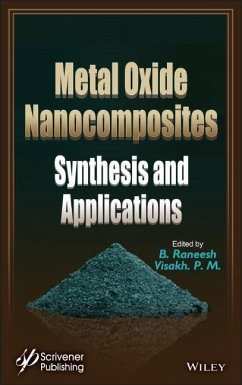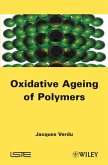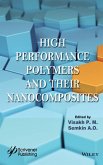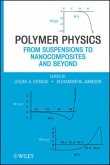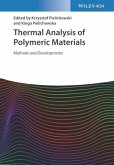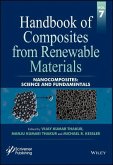Metal Oxide Nanocomposites
Synthesis and Applications
Herausgegeben:Raneesh, B.
Schade – dieser Artikel ist leider ausverkauft. Sobald wir wissen, ob und wann der Artikel wieder verfügbar ist, informieren wir Sie an dieser Stelle.
Metal Oxide Nanocomposites
Synthesis and Applications
Herausgegeben:Raneesh, B.
- Gebundenes Buch
- Merkliste
- Auf die Merkliste
- Bewerten Bewerten
- Teilen
- Produkt teilen
- Produkterinnerung
- Produkterinnerung
Metal Oxide Nanocomposites: Synthesis and Applications summarizes many of the recent research accomplishments in the area of metal oxide-based nanocomposites. This book focussing on the following topics: Nanocomposites preparation and characterization of metal oxide nanocomposites; synthesis of core/shell metal oxide nanocomposites; multilayer thin films; sequential assembly of nanocomposite materials; semiconducting polymer metal oxide nanocomposites; graphene-based metal and metal oxide nanocomposites; carbon nanotube-metal-oxide nanocomposites; silicon mixed oxide nanocomposites; gas…mehr
Andere Kunden interessierten sich auch für
![Nonlinear Polymer Rheology Nonlinear Polymer Rheology]() Shi-Qing WangNonlinear Polymer Rheology184,99 €
Shi-Qing WangNonlinear Polymer Rheology184,99 €![Oxydative Ageing of Polymers Oxydative Ageing of Polymers]() Jacques VerduOxydative Ageing of Polymers199,99 €
Jacques VerduOxydative Ageing of Polymers199,99 €![Handbook of Engineering and Specialty Thermoplastics, 4 Volume Set Handbook of Engineering and Specialty Thermoplastics, 4 Volume Set]() Johannes K. FinkHandbook of Engineering and Specialty Thermoplastics, 4 Volume Set832,99 €
Johannes K. FinkHandbook of Engineering and Specialty Thermoplastics, 4 Volume Set832,99 €![High Performance Polymers and Their Nanocomposites High Performance Polymers and Their Nanocomposites]() High Performance Polymers and Their Nanocomposites239,99 €
High Performance Polymers and Their Nanocomposites239,99 €![Polymer Physics Polymer Physics]() Polymer Physics217,99 €
Polymer Physics217,99 €![Thermal Analysis of Polymeric Materials Thermal Analysis of Polymeric Materials]() Thermal Analysis of Polymeric Materials199,00 €
Thermal Analysis of Polymeric Materials199,00 €![Handbook of Composites from Renewable Materials, Nanocomposites Handbook of Composites from Renewable Materials, Nanocomposites]() Handbook of Composites from Renewable Materials, Nanocomposites295,99 €
Handbook of Composites from Renewable Materials, Nanocomposites295,99 €-
-
-
Metal Oxide Nanocomposites: Synthesis and Applications summarizes many of the recent research accomplishments in the area of metal oxide-based nanocomposites. This book focussing on the following topics: Nanocomposites preparation and characterization of metal oxide nanocomposites; synthesis of core/shell metal oxide nanocomposites; multilayer thin films; sequential assembly of nanocomposite materials; semiconducting polymer metal oxide nanocomposites; graphene-based metal and metal oxide nanocomposites; carbon nanotube-metal-oxide nanocomposites; silicon mixed oxide nanocomposites; gas semiconducting sensors based on metal oxide nanocomposites; metal?]organic framework nanocomposite for hydrogen production and nanocomposites application towards photovoltaic and photocatalytic.
Produktdetails
- Produktdetails
- Verlag: Wiley & Sons / Wiley-Scrivener
- Artikelnr. des Verlages: 1W119363570
- 1. Auflage
- Seitenzahl: 432
- Erscheinungstermin: 17. Februar 2021
- Englisch
- Abmessung: 10mm x 10mm x 10mm
- Gewicht: 724g
- ISBN-13: 9781119363576
- ISBN-10: 1119363578
- Artikelnr.: 49387607
- Herstellerkennzeichnung
- Libri GmbH
- Europaallee 1
- 36244 Bad Hersfeld
- gpsr@libri.de
- Verlag: Wiley & Sons / Wiley-Scrivener
- Artikelnr. des Verlages: 1W119363570
- 1. Auflage
- Seitenzahl: 432
- Erscheinungstermin: 17. Februar 2021
- Englisch
- Abmessung: 10mm x 10mm x 10mm
- Gewicht: 724g
- ISBN-13: 9781119363576
- ISBN-10: 1119363578
- Artikelnr.: 49387607
- Herstellerkennzeichnung
- Libri GmbH
- Europaallee 1
- 36244 Bad Hersfeld
- gpsr@libri.de
B. Raneesh is an assistant professor in the Department of Physics, Catholicate College, Pathanamthitta, Kerala, India. He received his PhD in Physics from Mahatma Gandhi University, Kerala, India. His current research interests include multiferroics, thin films, nanocomposites, and electron microscopy. He has published more than 25 research articles in peer-reviewed international journals and has co-edited two books. Visakh P.M. is a prolific editor with more than 30 books published. Since 2017 he is an assistant professor at TUSUR University, Tomsk, Russia after completing his postdoc research at Tomsk Polytechnic University. He obtained his PhD, MPhil and MSc degrees from the School of Chemical Sciences, Mahatma Gandhi University, Kerala, India. He published more than 20 articles, 4 reviews and more than 30 book chapters and acts as guest editor for 4 international journals.
Preface xiii
1 Metal Oxide Nanocomposites: State-of-the-Art and New Challenges 1
Visakh P.M. and B. Raneesh
1.1 Introduction to Nanocomposites 1
1.2 Graphene-Based Metal and Metal Oxide Nanocomposites 4
1.3 Carbon Nanotube.Metal Oxide Nanocomposites 5
1.4 Metal Oxide-Based Nanocomposites Application Towards Photocatalysis 8
1.5 Metal Oxide Nanomaterials for Sensor Applications 9
1.6 Metal Oxide Nanocomposites and its Thermal Property Analysis 11
1.7 Semiconducting Metal Oxides for Photocatalytic and Gas Sensing Applications 13
1.8 Applications of Metal Oxide-Based Nanocomposites 14
References 16
2 Introduction to Nanocomposites 27
Ritu Malik, Vijay K. Tomer, Vandna Chaudhary, Nirav Joshi and Surender Duhan
2.1 Composites: An Introduction 28
2.2 Functions of Fibers and Matrix 28
2.3 Classification of Composites 30
2.4 Matrix Based Composites 30
2.4.1 Polymer Matrix Materials 30
2.4.1(a) Thermoplastics 31
2.4.1(b) Thermosets 32
2.4.2 Metal Matrix Materials 32
2.4.3 Ceramic Matrix Materials 33
2.4.4 Carbon Matrices 33
2.4.5 Glass Matrices 33
2.5 Reinforcements 34
2.5.1 Fiber Reinforcement 34
2.5.1(a) Glass Fiber 35
2.5.1(b) Metals Fibers 36
2.5.1(c) Alumina Fibers 36
2.5.1(d) Boron Fibers 36
2.5.1(e) Silicon Carbide Fibers 37
2.5.1(f) Aramid Fibers 37
2.5.1(g) Quartz and Silica Fibers 37
2.5.1(h) Graphite Fibers 38
2.5.2 Whiskers 38
2.5.3 Laminar Composites 38
2.5.4 Flake Composites 39
2.5.5 Filled Composites 39
2.5.6 Particulate Reinforced Composites 40
2.5.7 Cermets 40
2.5.8 Microspheres 40
2.5.8(a) Solid Glass Microspheres (SGM) 40
2.5.8(b) Hollow Microspheres (HM) 41
2.6 Polymer Composites 41
2.6.1 Glass Fiber-Reinforced Polymer (GFRP) Composites 42
2.6.2 Carbon Fiber-Reinforced Polymer (CFRP) Composites 43
2.6.3 Aramid Fiber-Reinforced Polymer Composites 43
2.7 Composites Processing 44
2.8 Composites Product Fabrication 44
2.9 Application of Composites 46
2.9.1 The Aerospace Industry 46
2.9.2 The Automotive Industry 46
2.9.3 The Sporting Goods Industry 47
2.9.4 Marine Applications 47
2.9.5 Consumer Goods 47
2.9.6 Construction and Civil Structures 47
2.9.7 Industrial Applications 48
2.10 Special Features of Composites 48
2.11 Composites vs Metals 49
2.12 Advantages of Composites 50
2.13 Disadvantage of Composites 51
2.14 Conclusion 51
Acknowledgments 51
References 52
3 Graphene-Based Metal and Metal Oxide Nanocomposites 55
Anupma Thakur, Rishabh Jain, Praveen Kumar and Pooja D
3.1 Introduction 55
3.2 Graphene 56
3.3 Reduced Graphene Oxide 60
3.4 Graphene-Based Composites 61
3.5 Graphene-Based Hybrid Nanocomposites 63
3.6 The Mechanics of Graphene Nanocomposites 65
3.7 Functionalization 66
3.7.1 Covalent Functionalization 66
3.7.2 Non-Covalent Functionalization 67
3.8 Thermal Properties 67
3.9 Conclusions 68
References 68
4 Carbon Nanotube.Metal Oxide Nanocomposites 73
Dengjun Wang, Wenjie Sun and Chunming Su
4.1 Introduction 74
4.2 Synthesis Methods 75
4.2.1 Ex Situ Approach 77
4.2.2 In Situ Ap
1 Metal Oxide Nanocomposites: State-of-the-Art and New Challenges 1
Visakh P.M. and B. Raneesh
1.1 Introduction to Nanocomposites 1
1.2 Graphene-Based Metal and Metal Oxide Nanocomposites 4
1.3 Carbon Nanotube.Metal Oxide Nanocomposites 5
1.4 Metal Oxide-Based Nanocomposites Application Towards Photocatalysis 8
1.5 Metal Oxide Nanomaterials for Sensor Applications 9
1.6 Metal Oxide Nanocomposites and its Thermal Property Analysis 11
1.7 Semiconducting Metal Oxides for Photocatalytic and Gas Sensing Applications 13
1.8 Applications of Metal Oxide-Based Nanocomposites 14
References 16
2 Introduction to Nanocomposites 27
Ritu Malik, Vijay K. Tomer, Vandna Chaudhary, Nirav Joshi and Surender Duhan
2.1 Composites: An Introduction 28
2.2 Functions of Fibers and Matrix 28
2.3 Classification of Composites 30
2.4 Matrix Based Composites 30
2.4.1 Polymer Matrix Materials 30
2.4.1(a) Thermoplastics 31
2.4.1(b) Thermosets 32
2.4.2 Metal Matrix Materials 32
2.4.3 Ceramic Matrix Materials 33
2.4.4 Carbon Matrices 33
2.4.5 Glass Matrices 33
2.5 Reinforcements 34
2.5.1 Fiber Reinforcement 34
2.5.1(a) Glass Fiber 35
2.5.1(b) Metals Fibers 36
2.5.1(c) Alumina Fibers 36
2.5.1(d) Boron Fibers 36
2.5.1(e) Silicon Carbide Fibers 37
2.5.1(f) Aramid Fibers 37
2.5.1(g) Quartz and Silica Fibers 37
2.5.1(h) Graphite Fibers 38
2.5.2 Whiskers 38
2.5.3 Laminar Composites 38
2.5.4 Flake Composites 39
2.5.5 Filled Composites 39
2.5.6 Particulate Reinforced Composites 40
2.5.7 Cermets 40
2.5.8 Microspheres 40
2.5.8(a) Solid Glass Microspheres (SGM) 40
2.5.8(b) Hollow Microspheres (HM) 41
2.6 Polymer Composites 41
2.6.1 Glass Fiber-Reinforced Polymer (GFRP) Composites 42
2.6.2 Carbon Fiber-Reinforced Polymer (CFRP) Composites 43
2.6.3 Aramid Fiber-Reinforced Polymer Composites 43
2.7 Composites Processing 44
2.8 Composites Product Fabrication 44
2.9 Application of Composites 46
2.9.1 The Aerospace Industry 46
2.9.2 The Automotive Industry 46
2.9.3 The Sporting Goods Industry 47
2.9.4 Marine Applications 47
2.9.5 Consumer Goods 47
2.9.6 Construction and Civil Structures 47
2.9.7 Industrial Applications 48
2.10 Special Features of Composites 48
2.11 Composites vs Metals 49
2.12 Advantages of Composites 50
2.13 Disadvantage of Composites 51
2.14 Conclusion 51
Acknowledgments 51
References 52
3 Graphene-Based Metal and Metal Oxide Nanocomposites 55
Anupma Thakur, Rishabh Jain, Praveen Kumar and Pooja D
3.1 Introduction 55
3.2 Graphene 56
3.3 Reduced Graphene Oxide 60
3.4 Graphene-Based Composites 61
3.5 Graphene-Based Hybrid Nanocomposites 63
3.6 The Mechanics of Graphene Nanocomposites 65
3.7 Functionalization 66
3.7.1 Covalent Functionalization 66
3.7.2 Non-Covalent Functionalization 67
3.8 Thermal Properties 67
3.9 Conclusions 68
References 68
4 Carbon Nanotube.Metal Oxide Nanocomposites 73
Dengjun Wang, Wenjie Sun and Chunming Su
4.1 Introduction 74
4.2 Synthesis Methods 75
4.2.1 Ex Situ Approach 77
4.2.2 In Situ Ap
Preface xiii
1 Metal Oxide Nanocomposites: State-of-the-Art and New Challenges 1
Visakh P.M. and B. Raneesh
1.1 Introduction to Nanocomposites 1
1.2 Graphene-Based Metal and Metal Oxide Nanocomposites 4
1.3 Carbon Nanotube.Metal Oxide Nanocomposites 5
1.4 Metal Oxide-Based Nanocomposites Application Towards Photocatalysis 8
1.5 Metal Oxide Nanomaterials for Sensor Applications 9
1.6 Metal Oxide Nanocomposites and its Thermal Property Analysis 11
1.7 Semiconducting Metal Oxides for Photocatalytic and Gas Sensing Applications 13
1.8 Applications of Metal Oxide-Based Nanocomposites 14
References 16
2 Introduction to Nanocomposites 27
Ritu Malik, Vijay K. Tomer, Vandna Chaudhary, Nirav Joshi and Surender Duhan
2.1 Composites: An Introduction 28
2.2 Functions of Fibers and Matrix 28
2.3 Classification of Composites 30
2.4 Matrix Based Composites 30
2.4.1 Polymer Matrix Materials 30
2.4.1(a) Thermoplastics 31
2.4.1(b) Thermosets 32
2.4.2 Metal Matrix Materials 32
2.4.3 Ceramic Matrix Materials 33
2.4.4 Carbon Matrices 33
2.4.5 Glass Matrices 33
2.5 Reinforcements 34
2.5.1 Fiber Reinforcement 34
2.5.1(a) Glass Fiber 35
2.5.1(b) Metals Fibers 36
2.5.1(c) Alumina Fibers 36
2.5.1(d) Boron Fibers 36
2.5.1(e) Silicon Carbide Fibers 37
2.5.1(f) Aramid Fibers 37
2.5.1(g) Quartz and Silica Fibers 37
2.5.1(h) Graphite Fibers 38
2.5.2 Whiskers 38
2.5.3 Laminar Composites 38
2.5.4 Flake Composites 39
2.5.5 Filled Composites 39
2.5.6 Particulate Reinforced Composites 40
2.5.7 Cermets 40
2.5.8 Microspheres 40
2.5.8(a) Solid Glass Microspheres (SGM) 40
2.5.8(b) Hollow Microspheres (HM) 41
2.6 Polymer Composites 41
2.6.1 Glass Fiber-Reinforced Polymer (GFRP) Composites 42
2.6.2 Carbon Fiber-Reinforced Polymer (CFRP) Composites 43
2.6.3 Aramid Fiber-Reinforced Polymer Composites 43
2.7 Composites Processing 44
2.8 Composites Product Fabrication 44
2.9 Application of Composites 46
2.9.1 The Aerospace Industry 46
2.9.2 The Automotive Industry 46
2.9.3 The Sporting Goods Industry 47
2.9.4 Marine Applications 47
2.9.5 Consumer Goods 47
2.9.6 Construction and Civil Structures 47
2.9.7 Industrial Applications 48
2.10 Special Features of Composites 48
2.11 Composites vs Metals 49
2.12 Advantages of Composites 50
2.13 Disadvantage of Composites 51
2.14 Conclusion 51
Acknowledgments 51
References 52
3 Graphene-Based Metal and Metal Oxide Nanocomposites 55
Anupma Thakur, Rishabh Jain, Praveen Kumar and Pooja D
3.1 Introduction 55
3.2 Graphene 56
3.3 Reduced Graphene Oxide 60
3.4 Graphene-Based Composites 61
3.5 Graphene-Based Hybrid Nanocomposites 63
3.6 The Mechanics of Graphene Nanocomposites 65
3.7 Functionalization 66
3.7.1 Covalent Functionalization 66
3.7.2 Non-Covalent Functionalization 67
3.8 Thermal Properties 67
3.9 Conclusions 68
References 68
4 Carbon Nanotube.Metal Oxide Nanocomposites 73
Dengjun Wang, Wenjie Sun and Chunming Su
4.1 Introduction 74
4.2 Synthesis Methods 75
4.2.1 Ex Situ Approach 77
4.2.2 In Situ Ap
1 Metal Oxide Nanocomposites: State-of-the-Art and New Challenges 1
Visakh P.M. and B. Raneesh
1.1 Introduction to Nanocomposites 1
1.2 Graphene-Based Metal and Metal Oxide Nanocomposites 4
1.3 Carbon Nanotube.Metal Oxide Nanocomposites 5
1.4 Metal Oxide-Based Nanocomposites Application Towards Photocatalysis 8
1.5 Metal Oxide Nanomaterials for Sensor Applications 9
1.6 Metal Oxide Nanocomposites and its Thermal Property Analysis 11
1.7 Semiconducting Metal Oxides for Photocatalytic and Gas Sensing Applications 13
1.8 Applications of Metal Oxide-Based Nanocomposites 14
References 16
2 Introduction to Nanocomposites 27
Ritu Malik, Vijay K. Tomer, Vandna Chaudhary, Nirav Joshi and Surender Duhan
2.1 Composites: An Introduction 28
2.2 Functions of Fibers and Matrix 28
2.3 Classification of Composites 30
2.4 Matrix Based Composites 30
2.4.1 Polymer Matrix Materials 30
2.4.1(a) Thermoplastics 31
2.4.1(b) Thermosets 32
2.4.2 Metal Matrix Materials 32
2.4.3 Ceramic Matrix Materials 33
2.4.4 Carbon Matrices 33
2.4.5 Glass Matrices 33
2.5 Reinforcements 34
2.5.1 Fiber Reinforcement 34
2.5.1(a) Glass Fiber 35
2.5.1(b) Metals Fibers 36
2.5.1(c) Alumina Fibers 36
2.5.1(d) Boron Fibers 36
2.5.1(e) Silicon Carbide Fibers 37
2.5.1(f) Aramid Fibers 37
2.5.1(g) Quartz and Silica Fibers 37
2.5.1(h) Graphite Fibers 38
2.5.2 Whiskers 38
2.5.3 Laminar Composites 38
2.5.4 Flake Composites 39
2.5.5 Filled Composites 39
2.5.6 Particulate Reinforced Composites 40
2.5.7 Cermets 40
2.5.8 Microspheres 40
2.5.8(a) Solid Glass Microspheres (SGM) 40
2.5.8(b) Hollow Microspheres (HM) 41
2.6 Polymer Composites 41
2.6.1 Glass Fiber-Reinforced Polymer (GFRP) Composites 42
2.6.2 Carbon Fiber-Reinforced Polymer (CFRP) Composites 43
2.6.3 Aramid Fiber-Reinforced Polymer Composites 43
2.7 Composites Processing 44
2.8 Composites Product Fabrication 44
2.9 Application of Composites 46
2.9.1 The Aerospace Industry 46
2.9.2 The Automotive Industry 46
2.9.3 The Sporting Goods Industry 47
2.9.4 Marine Applications 47
2.9.5 Consumer Goods 47
2.9.6 Construction and Civil Structures 47
2.9.7 Industrial Applications 48
2.10 Special Features of Composites 48
2.11 Composites vs Metals 49
2.12 Advantages of Composites 50
2.13 Disadvantage of Composites 51
2.14 Conclusion 51
Acknowledgments 51
References 52
3 Graphene-Based Metal and Metal Oxide Nanocomposites 55
Anupma Thakur, Rishabh Jain, Praveen Kumar and Pooja D
3.1 Introduction 55
3.2 Graphene 56
3.3 Reduced Graphene Oxide 60
3.4 Graphene-Based Composites 61
3.5 Graphene-Based Hybrid Nanocomposites 63
3.6 The Mechanics of Graphene Nanocomposites 65
3.7 Functionalization 66
3.7.1 Covalent Functionalization 66
3.7.2 Non-Covalent Functionalization 67
3.8 Thermal Properties 67
3.9 Conclusions 68
References 68
4 Carbon Nanotube.Metal Oxide Nanocomposites 73
Dengjun Wang, Wenjie Sun and Chunming Su
4.1 Introduction 74
4.2 Synthesis Methods 75
4.2.1 Ex Situ Approach 77
4.2.2 In Situ Ap

